Stephanie dropped me off at the trailhead at dusk with my planned destination being a dry ridge about 600 feet of climbing higher. I had crossed this ridge once before on a previous trip and thought that it would make a nice campsite.
Although my trailhead was located within the confines of Rocky Mountain National Park, I soon exited the park boundary. I would need no reservations for camping tonight.
After 15 minutes of climbing, I stopped to make some pack adjustments and looked back down to the valley. A small herd of elk was feeding on meadow grasses, and the bull was bugling. A hundred yards upstream, a large cow moose was munching in the willows. Three deer were moseying along the valley trail between them.
I feel fortunate to live in a place where I can be at a National Park trailhead within 10 minutes of my home, and where I can see big game animals every day. This morning, a herd of 300 elk walked through the parking lot of our apartment building. We watched them from our deck.
After adjusting my pack, I shed my rain jacket, as I was starting the steep climb to the ridge. The temperature was below freezing, but a fishnet tank top and an alpaca long-sleeve crew would be plenty of insulation while hiking uphill.
I placed my headlamp around my neck, I would need it soon.
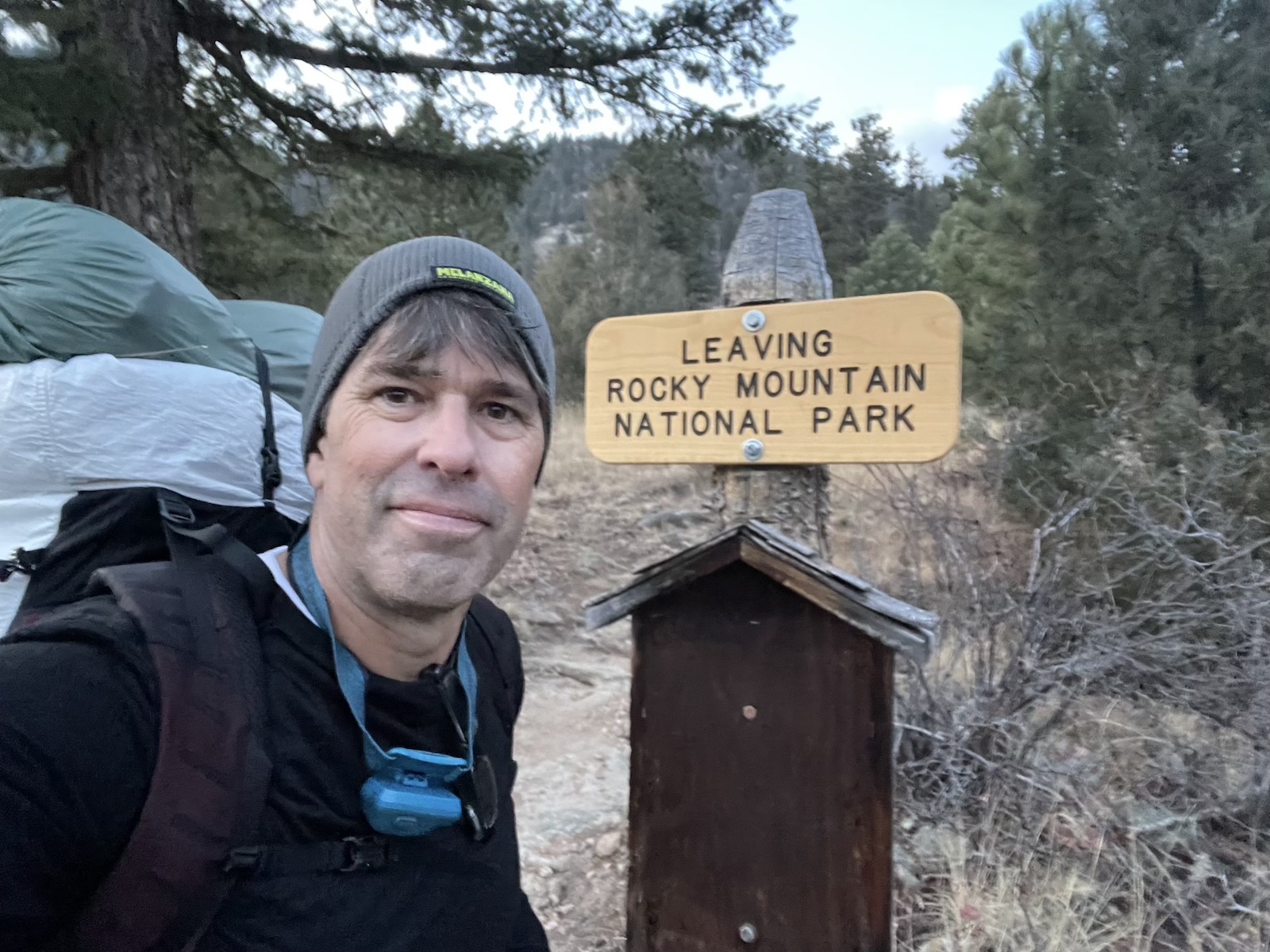
This would be a quick trip, less than 24 hours, and only about 9 miles. I had one singular purpose: collect more tent-testing data for my “How do ultralight double-wall tents perform in the winter?” project. Tonight’s home would be the Tarptent Dipole 1 DW.
I arrived at the crest of the ridge well after dark, but the rising full moon helped me avoid destroying my night vision, and my headlamp stayed off. After I found a spot to pitch, I clicked it on, flooding the area with 400 lumens of LED light, and removed my pack.
My campsite was nestled in a copse of pine trees – a mix of ponderosa and limber pines at about 8,600 feet. The forest floor was soft, duffy, and dry. That would change overnight. The winter storm warning issued a few hours ago called for heavy snowfall that would start in a few hours.
After pitching the shelter and setting up my bed, I boiled water for dinner – a package of Good To-Go Thai Curry. After filling the bag and sealing it, I stuffed it in my down parka while it rehydrated – a process I’ve done hundreds of times. I love the feeling of heat against my belly on a cold night.
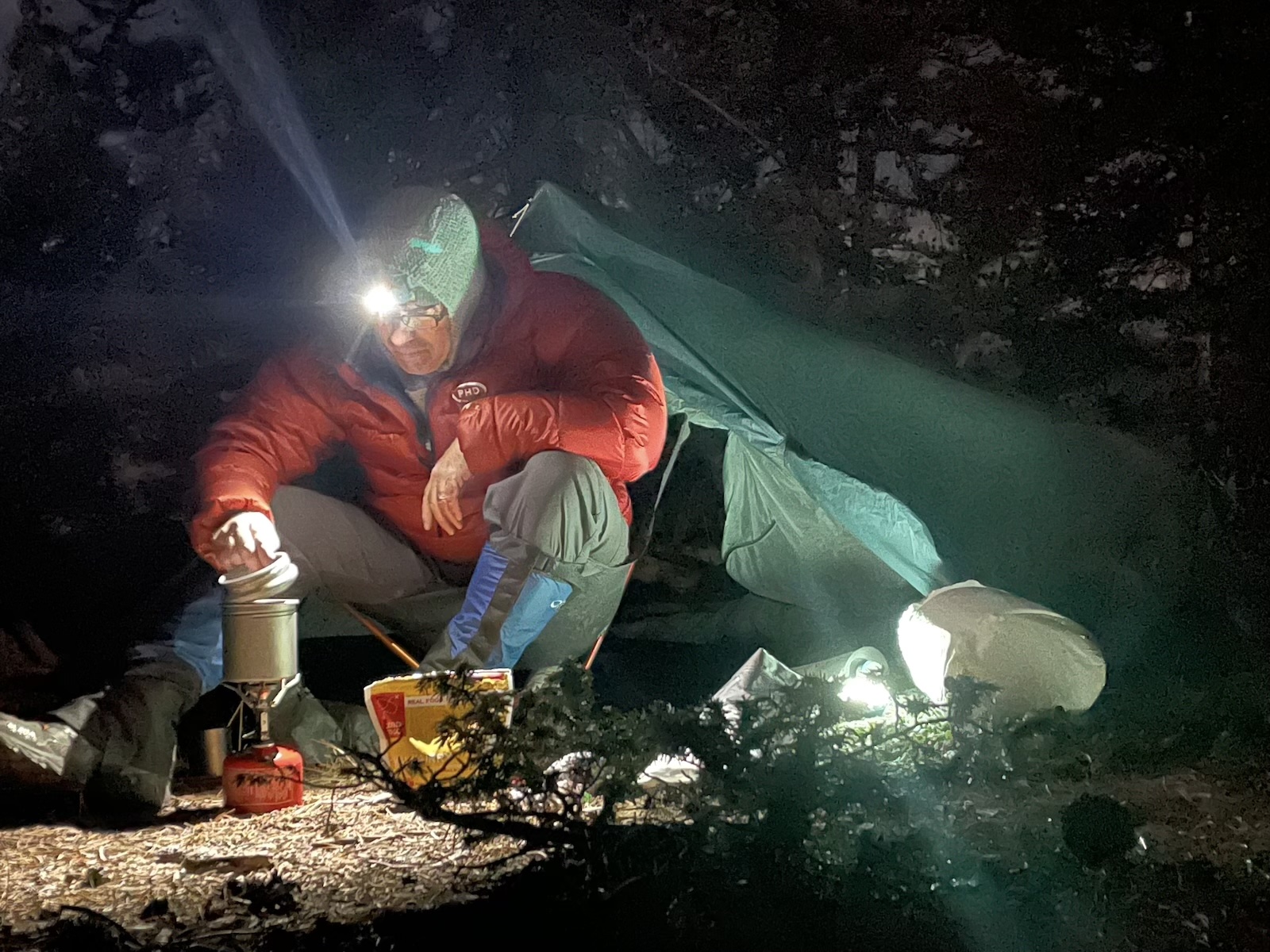
For the next 10 minutes, I organized gear, made some tent guyline adjustments to prepare for heavy snow, and enjoyed the aura of the brightening moon as it rose above the tops of the trees.
And then, I felt an unusual amount of heat coming from my freeze-dried dinner.
When I realized what had happened, I panicked. My clothing was being soaked by food slop from a leaky bag. I opened the bottom of my parka hem and let the package fall to the ground, then started yanking my clothes off. First, the parka – with its inside fabric (and some insulation) fully soaked. My Alpha 60, alpaca, and fishnet layers were also soaked, as well as the tops of my underwear and pants. What a mess.
I figured on just washing my clothes out in the creek, but then remembered that I was dry-camping, and the nearest water source was an hour’s walk in the dark. I only had about 3 liters of water with me, so I did the best I could to wash as much out of the down parka as possible (the most critical layer). I was able to wash and rinse the fishnet and alpaca layers well enough, but the Alpha 60 layer was not salvageable. I used a wetted bandana to wipe the residue off my pants and underwear.
Through most of this process, I was cursing the zipper people at Good To-Go, thinking that maybe they had taken their Food Packaging 101 class online during the pandemic, compromising their education.
But after my clothes were washed, draped over limber pine branches, and starting to freeze, I realized that I was standing shirtless on a moonlit night in the middle of the forest with temperatures in the mid-20s F and dropping.
I started to laugh and then realized I was shivering.
I quickly donned my curry-odored base layers and down jacket, wondering what the resident bears were up to (hyperphagia) and where they were (I saw no tracks on the way up to my camp). I stowed my Alpha hoody in a gallon ziplock and stuffed it into my Ursack.
Still shivering, and now wearing half-frozen base layers against my skin, I started to gather wood for a warming fire (another advantage of camping outside the Park boundary).
Within 10 minutes, I had a nice blaze going, so I removed my layers again and spread them to dry in front of the fire, enjoying the radiant heat from the flames on the bare skin of my torso.
I spent the next hour warming up and drying clothes, and eating my now-lukewarm Thai curry. Which, incidentally, was quite delicious. Its flavor motivated me to forgive the zipper people.
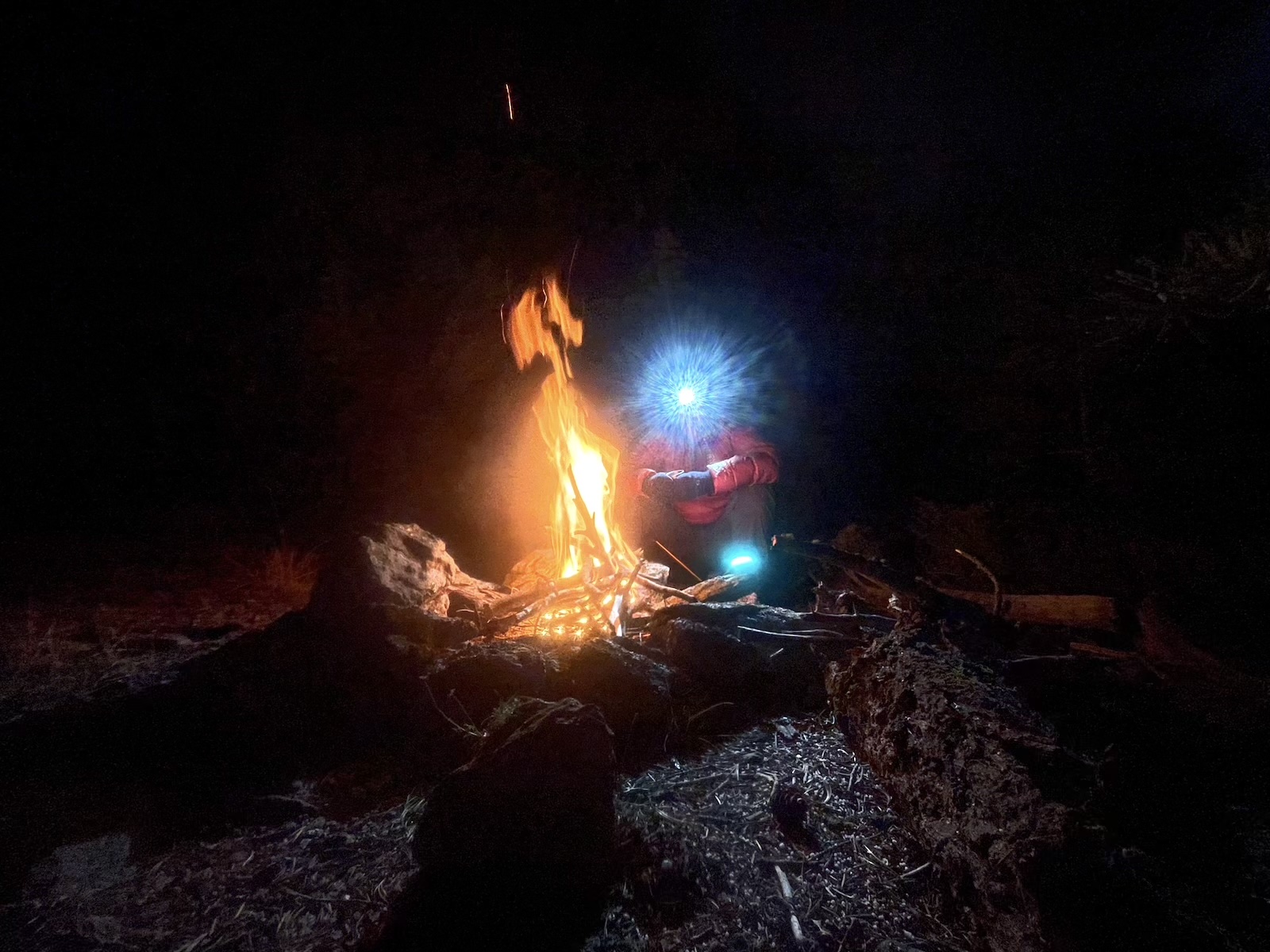
I spent a few minutes collecting data. The sky was clear, and the outside temperature was 23 degrees F. The temperature inside my tent – without me inside of it – was 28 degrees F. I was surprised and pleased that the tent fabrics were providing some protection against radiative heat losses to the clear night sky. I’d never seen a difference this dramatic in a single wall tent, or a tent with a DCF fly.
After my layers dried, I put them on again, doused the fire with sand, and retired to my tent.
I turned my lantern on 80s mood mode, and wrote for a while, a thousand words that would provide the first draft of the introduction to my Tarptent Dipole 1 DW Review. After half an hour, I collected some more data. Still 23 degrees F outside, but now a balmy 35 inside my tent. I made the decision not to sleep with my water bottles inside my quilt.
I stripped off my parka, cinched the collar of my quilt, and closed my eyes. I noted that the tent smelled like an Indian restaurant. I listened for the footsteps of a bear but heard nothing more than the gentle hooting of an owl a few trees down. That lone sound of the forest night lulled me to sleep quickly.
I had given some thought to the idea that my odoriferous state during hyperphagia season was not the ideal manifestation of LNT No. 6 (Respect Wildlife). But the idea of bagging camp in the dark and stumbling down steep terrain came with its own set of risks. I opted to stay and camp on this trip, in an area where black bear density is relatively low (I may have made a different decision if I were camping in grizzly bear habitat). While I do adhere to strict formulas in life-and-death situations (e.g., press the SOS button on my inReach if I break my leg with a compound fracture) or in situations where choices are easy (e.g., don’t camp within 100 feet of a stream or lake), the hazard-risk matrix becomes murkier when facing decisions where all choices are problematic.
I awoke a few hours later to the familiar sound of light snow pattering on the tent fly. The outside temperature was 24 degrees F, and the inside temperature was 36 degrees F. I wiped my hand across the inside walls of the inner tent. No condensation. I checked the humidity levels on my sensors. Outside: 95%, inside: 85%. I fell back asleep.
A loud whoosh woke me up at 2 AM. It startled and confused me at first. Then, I realized it was snow sloughing off the sidewalls of the tent. I shined my headlamp around and noticed snow accumulating on the tent fly. When camping in ultralight tents, I usually make a habit of banging the tent walls to knock the snow off, to avoid the inevitable snow loading that collapses trekking pole-supported tents during snowstorms.
I decided to ignore the accumulating snow instead. Let’s see what happens. I fell back asleep.
The whooshes came frequently throughout the night. Snow accumulated, and then avalanched, off both the sidewalls and roof panels of the Dipole 1 DW. I was surprised, and happy, thinking that this tent could become a legitimate candidate for a treeline winter tent.
And I was warm. In reviewing my sensor data the next morning, the inside of the tent was always at least 9 degrees F warmer than the outside air temperature, and the inside humidity never exceeded 95%. When I checked for condensation accumulation on the inner tent when I woke up at sunrise, I found nothing more than a very thin film of moisture.
When it was light enough to see without a headlamp, I unzipped the inner tent door and smiled at the snow that had accumulated around the vestibule perimeter. Our second winter storm! This is my favorite season for backcountry exploration.
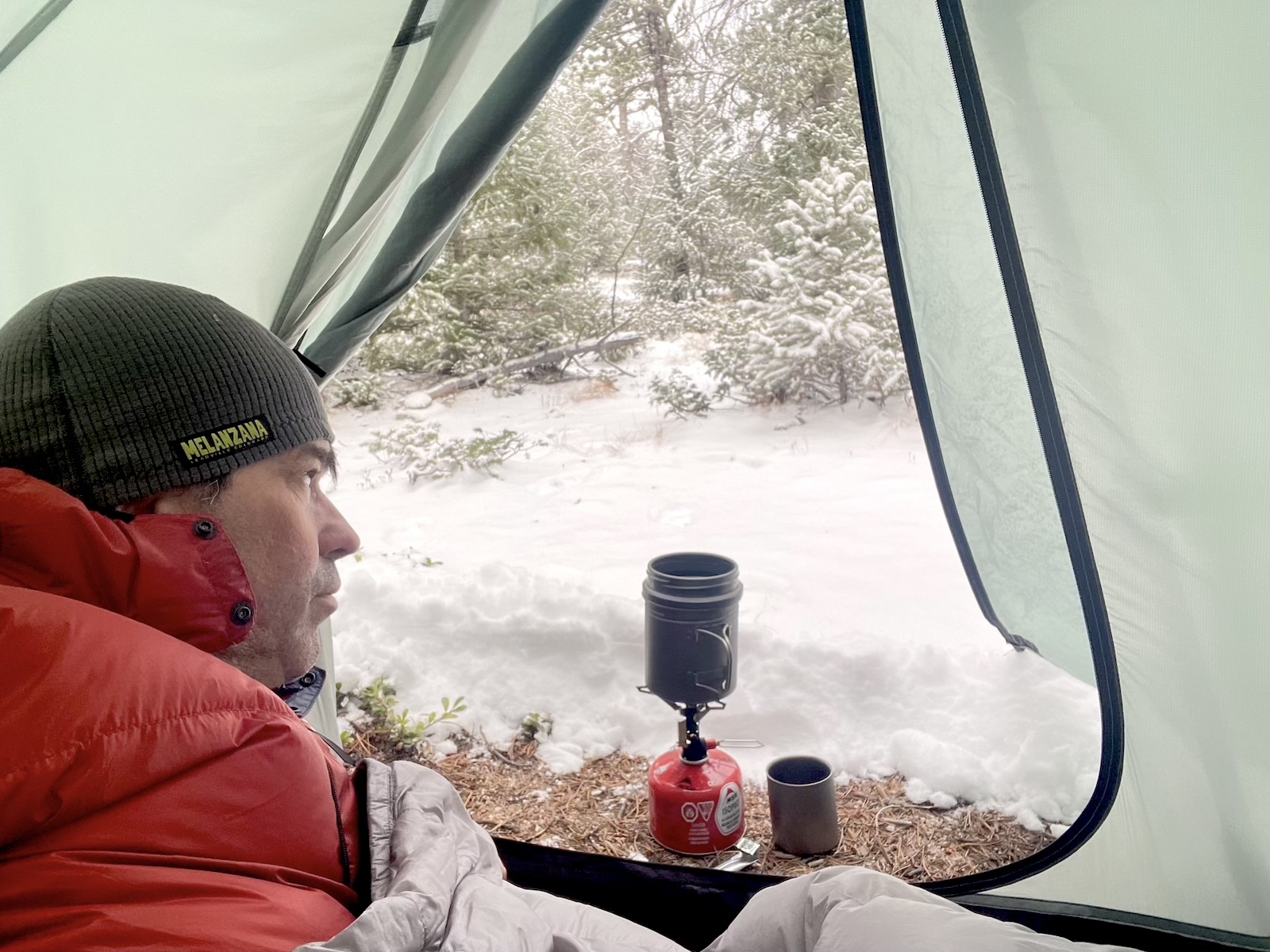
Remaining tucked inside my quilt, I managed to fill my BOT with water, light the stove, and start the first morning brew. I poured the first batch into my new mug, unzipped the vestibule, and watched the snow continue to fall as a brown hare twitched its ears from thirty feet away whenever I slurped.
I finished my coffee and reluctantly exited my tent to empty my bladder. The snow crunched under my down booties and heavy snowfall was starting to wet my curried alpaca pajama top. I hustled back into my shelter, zipped myself in, shimmied into my quilt, and fell back asleep as another whoosh of snow fell off the walls of the tent.

When I woke again, it was to another whoosh. I unzipped the door to the inner tent a little, peered out, and noticed that a few more inches had fallen. It was snowing heavily. I donned my parka, wrote a few hundred words more, and then felt the urgency to break camp so I could meet Stephanie and Chase at an afternoon rendezvous at an alpine lake in Rocky Mountain National Park.
I packed my quilt and pad, and not wanting to pack up or cook under falling snow, I unclipped the inner tent from the fly and packed it away. This left me with plenty of room under the fly to sit in my chair, cook a hot breakfast, and pack up my gear without exposing myself to the snowstorm.
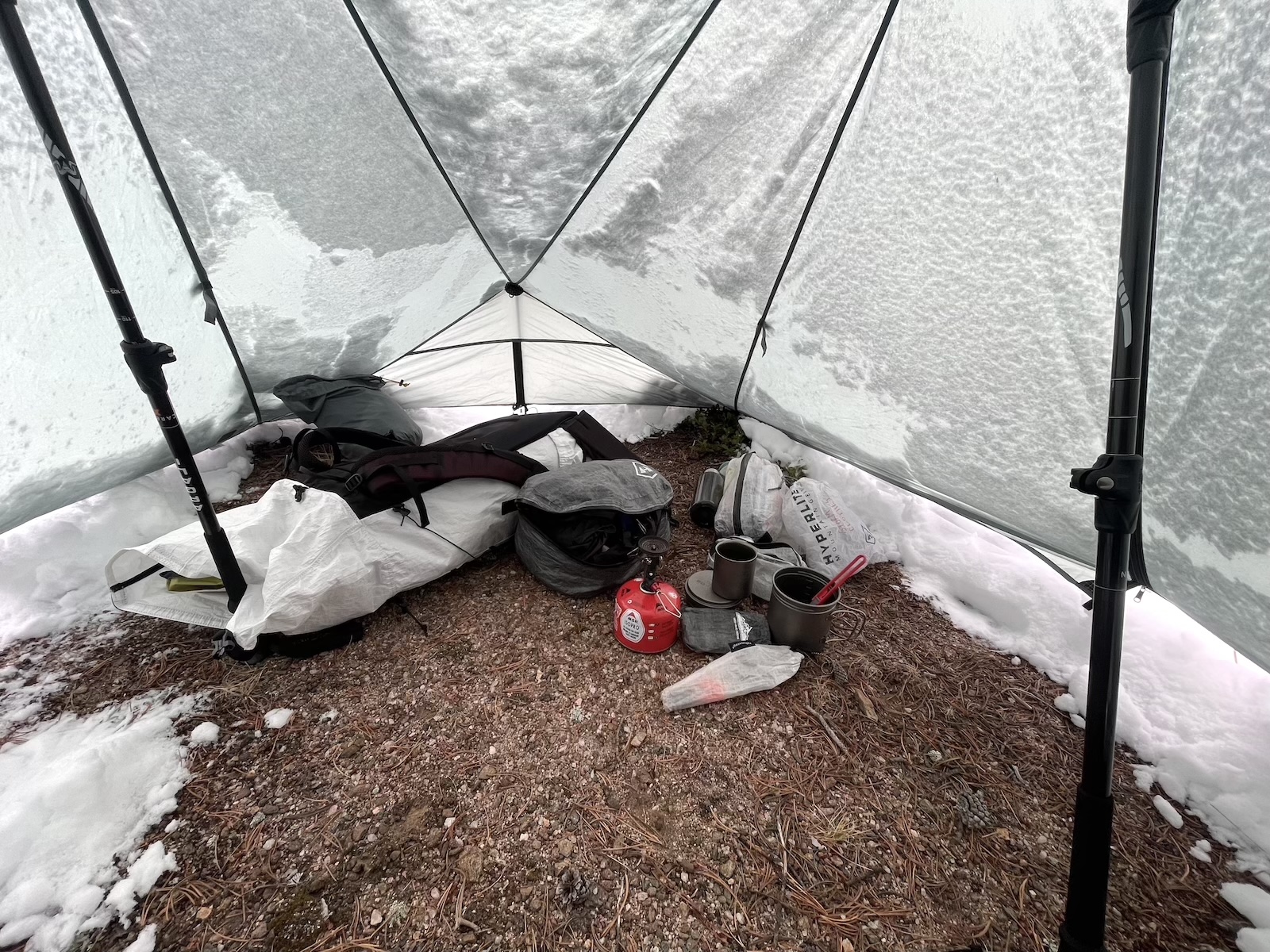
Finally, it was go time. Everything was in my pack except the tent fly, and I was dressed for trekking in blizzard conditions.
Within two minutes, I had exited the tent, unpitched it, packed it up, and was on my way. I started out wearing spikes but quickly removed them. The temperature was in the high 20s F and snow was balling underneath the crampons. The bare lug soles of my boots would fare much better for the rest of the day.
I staggered down the slippery slope back to the valley where I started my hike, keeping my eye out for bull elk and moose, who are sort of agitated this time of year. When I reached the valley floor and the trail, I moderated my pace to keep my heart rate well below my aerobic threshold. This hike was not to be a training-stress hike, as I was still recovering from the flu that I enjoyed on my last adventure a few weeks ago.
The snow eased up a bit as I crossed a stream and peered into its deep pools looking for trout. I spotted four and instantly regretted not packing my tenkara rod.
As I left the stream, the elevation gain met me. I monitored my watch continuously, to make sure I wasn’t overexerting myself. It didn’t take much for me to slow to a crawl as I climbed. As I watched my pace dip below 1 mph, I reminded myself that I was recovering from illness, and it was OK. Nevertheless, it was demoralizing.
I didn’t take any breaks and just kept plugging along to Rendezvous Lake.
I arrived about a half hour before our meetup time, so I found shelter under a thousand-year-old bristlecone and fetched my stove.
It was late in the day, and I was trying to create new sleep habits, so I made a mocha cuppa with Swiss Miss and decaf, and discovered that it was a new, but immensely enjoyable afternoon drink!
The snow started to fall heavily, so I donned my parka and meditated, alone, towards the small bit of water that remained unfrozen, focusing on the dripping icicles hanging from the rock cliff that framed the lake.
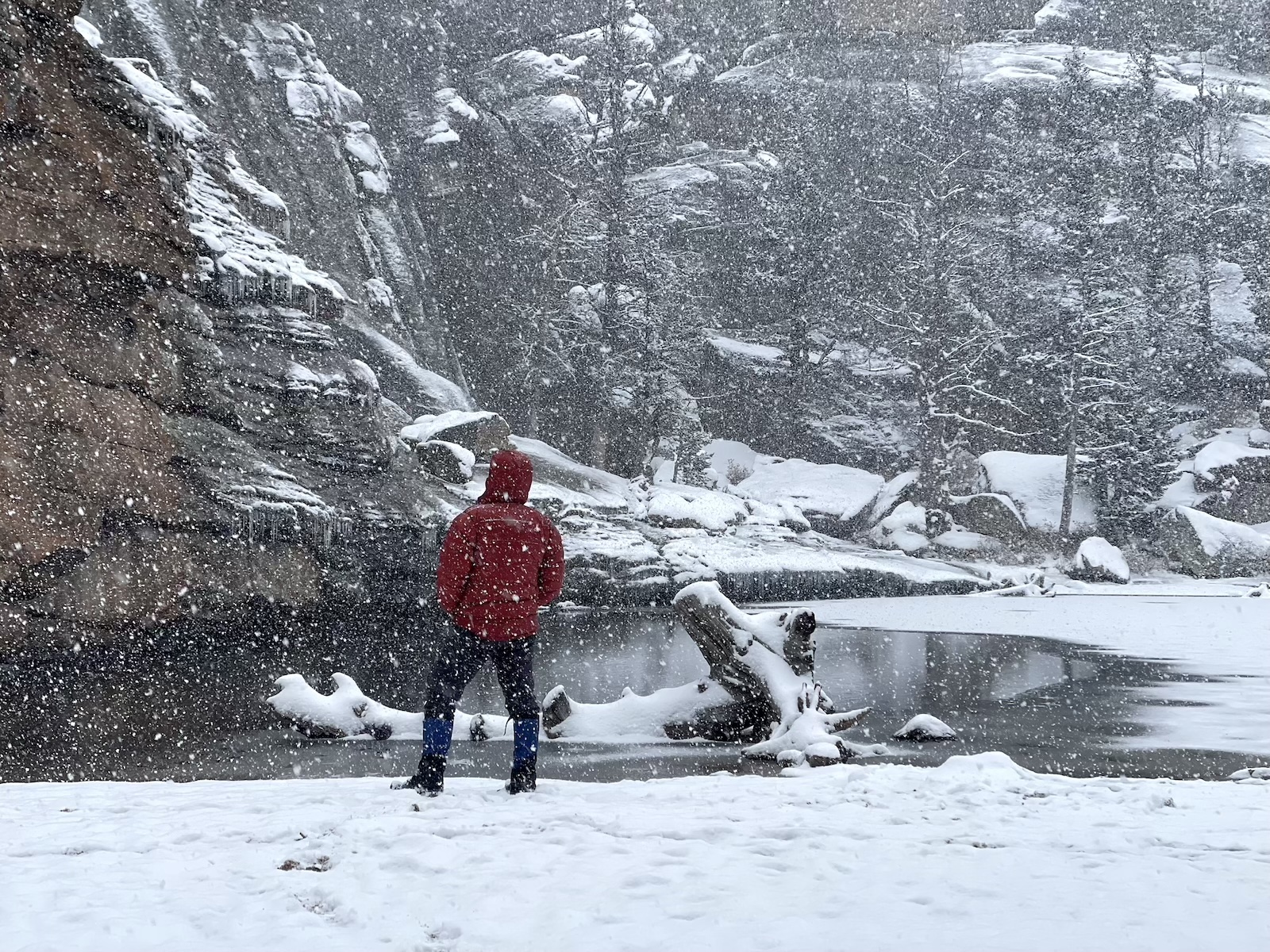
I caught some movement out of the corner of my eye to my right and peered through the fog-snow to the other side of the lake, where an apparition was emerging towards the shoreline. We waved at each other. In a few minutes, Stephanie and Chase greeted me and we snapped a few photos.
I was chilled, so I kept my down parka on as I slung my pack over my shoulder. I rarely hike in high-loft insulation, but today, I appreciated being warm and cozy during the final two miles of my hike down to the trailhead.

Gear Notes
- Shelter – Tarptent Dipole 1 DW. This trip really hit the sweet spot of comfort for an ultralight double-walled tent. Temperatures a few degrees below freezing, which allowed for temperatures inside the tent to climb to a few degrees above freezing with no condensation inside. Very impressive snow-loading and snow-shedding capability. No deformation of shelter under a moderate snow load.
- Sleeping Pad – Nemo Tensor Extreme. Although I appreciate the warmth of this pad in cold temperatures, it’s the stability (and how it translates to comfort for me) that I’m most excited about. A big step up in comfort over the Nemo Tensor Ultralight Insulated pad I’ve been using for the past several years.
- Sleeping Bag – Hyperlite Mountain Gear 20 Quilt. Paired with a variety of high-loft winter insulating layers, this quilt is the core of my winter sleep system when I’m spending the night in a tent (and out of the wind) and am not expecting temperatures inside the tent to go below about 5 degrees F. The wide girth accommodates the added loft of my winter parkas and insulating pants.
- Pack – Outdoor Vitals CS40. My first trip with this pack. It’s a little small for winter backpacking, but I didn’t have high-volume winter gear on this trip. It features a slim (as opposed to bulbous) packbag, a carbon fiber internal frame, and generously-padded shoulder straps, hip belt, and back panel. Tiny buckles were hard to use while wearing mitten shells.
- Parka – PhD Yukon K Hoodie. My torso insulation of choice for temperatures down to about 15 degrees F.
- Rain Jacket – Outdoor Vitals Tushar Rain Jacket. Nice fit and the fabric has a durable, stiff hand that makes this feel like a high-end jacket when you first wear it. Lack of ventilation features (tiny pit zips, a small mesh-backed chest pocket, and no ventilation control at the wrist cuffs) make for a clammy affair when working hard. Might be a good option for those who want durability but in a minimalist jacket design that spends most of its time in your pack and works well enough for the occasional rainstorm.
- Base Layers – Brynje + Arms of Andes. I’ve been experimenting more with alpaca wool this season, and am finally ready to replace my merino layers with it. It has a slightly higher warmth-to-weight ratio and is more hydrophobic than my merino options. That means I can sense perspiration before it starts to wet out my base layer, which I have a harder time doing with Merino wool fabrics.
- Mid Layers – Senchi Designs Alpha 60 Hoodie and Leggings. The warmth-to-weight ratio of Alpha 60 blows my mind. If not for its limited durability, the Alpha 60 Hoodie would be my favorite cool-weather hiking layer (worn over a Brynje fishnet t-shirt). However, I have to relegate this to a mid-layer that I take for cold-weather insurance. I do sleep in both, which makes for luxurious pajamas!
- Shoes – La Sportiva Ultra Raptor Mid GTX Wide. The wide forefoot, very lightweight, and terrific traction on snow makes these my favorite boots for mild winter conditions. I sized them two sizes larger than my foot size to accommodate boot-weight hiking socks and a layer of Goretex socks if needed.
- Gaiters – Outdoor Research Verglas. More nimble than OR Rocky Mountain High Gaiters, and lighter than OR Crocodiles, the Verglas is what a lightweight winter gaiter should be. It offers durability (Cordura lower) and security (straps instead of cords) that ultralight gaiters can’t provide.
- Booties – Goosefeet Gear Down Socks. I bring these when I know low temperatures are going to be well below freezing, and only wear them for sleeping or hanging out in the tent. If the forest floor isn’t too covered with poky litter, I’ll just wear these outside during middle-of-the-night nature calls.
- Firestarting Kit – Tinder-Quik + Firesteel. This was the first fire I’ve built in more than a year. I’m glad I still had a tiny firestarting kit tucked away in my “just-in-case” supply bag.
- Gloves – Outdoor Research Flurry Sensor. My favorite cold-weather glove. The hydrophobic wool outer prevents light snow from absorbing into it, and the inner fleece liner is cozy. They fit me well and I can perform most tasks while wearing them. Very warm for their weight.
- Overmitts – Outdoor Research Revel Shell Mitts. Essential when temperatures drop or I have to hike or deal with the tent or collect firewood in snowy conditions.
- Lantern – Black Diamond Moji +Lantern. For 2.6 ounces, it’s a bit of an unnecessary luxury item in an ultralight backpacking kit but provides nice mood lighting both in and out of the tent during the longer nights of the fall and winter seasons.
- Dinner – Good To-Go Thai Curry. An outstanding dish, just be careful with the bag zipper while rehydrating!
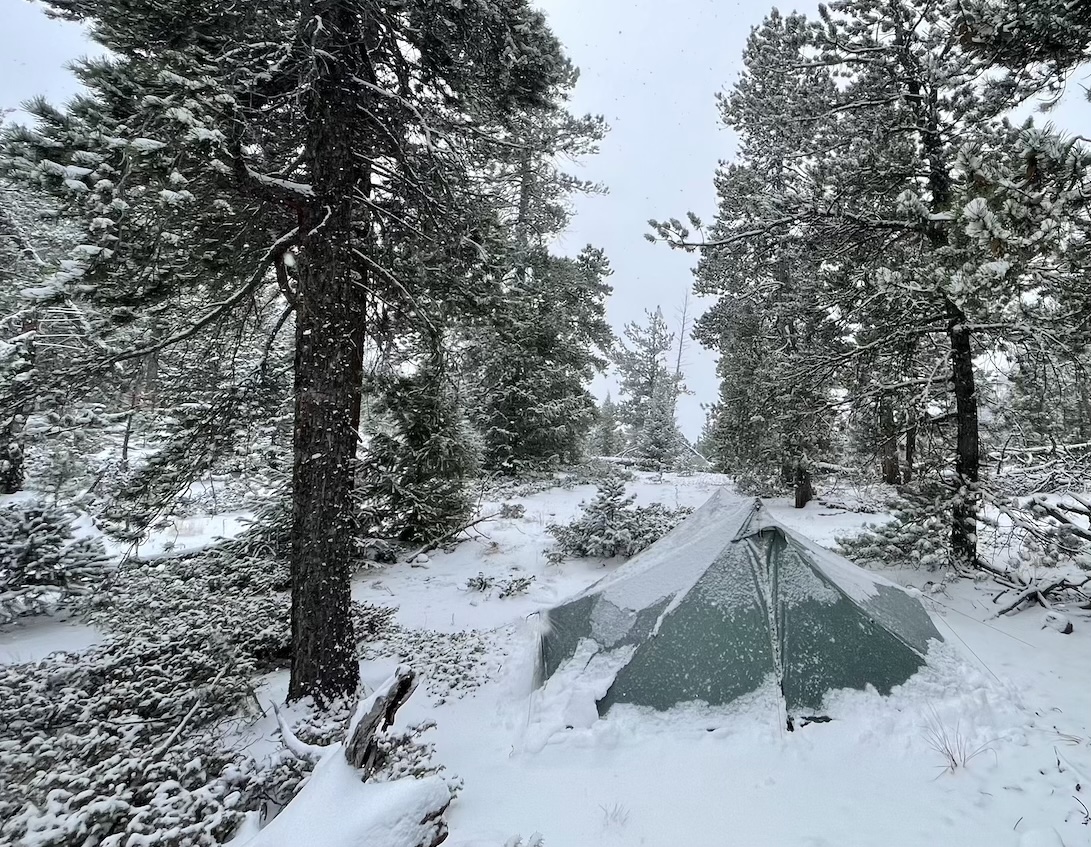
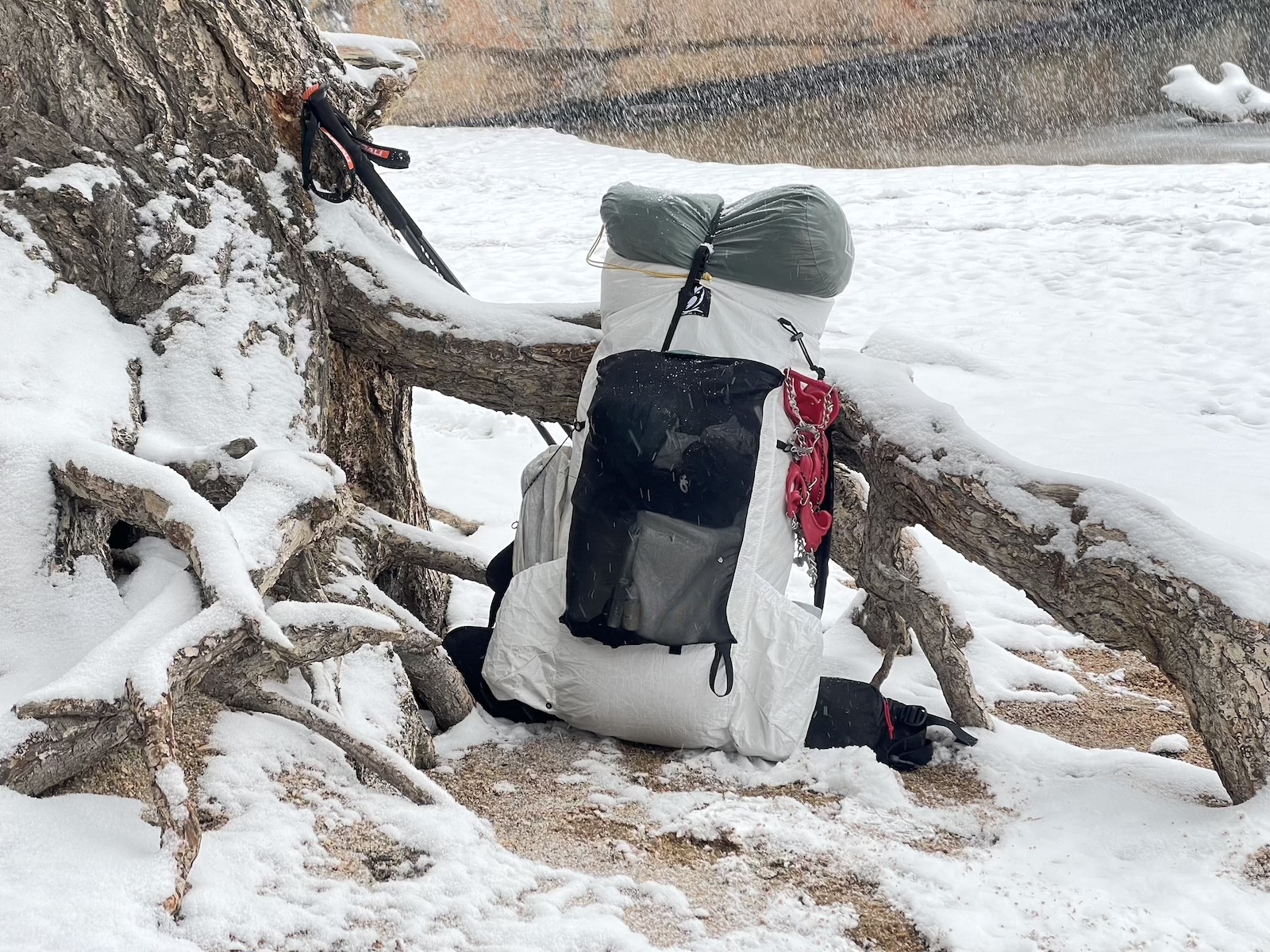

Related Content:
- Trailhead: Winter Backpacking Trailhead
- Gear: Nemo Tensor Insulated Sleeping Pad Review
- Wilderness Skills: Lightweight Backpacking in the Winter: Gear and Techniques from the Arctic
- Places: Careening into Winter

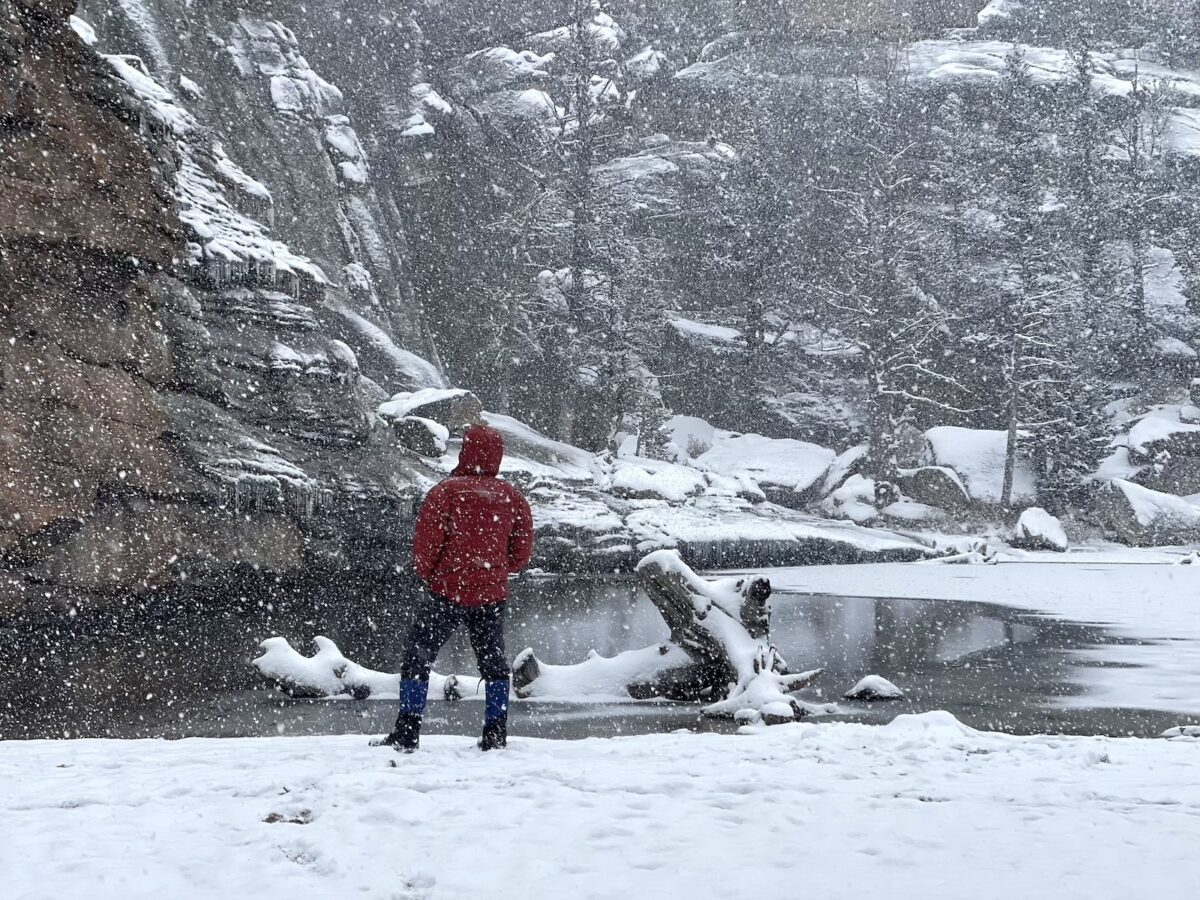


Home › Forums › Field Notes: Curry and Fire